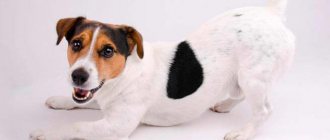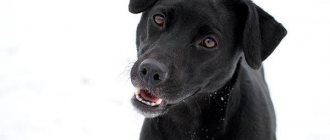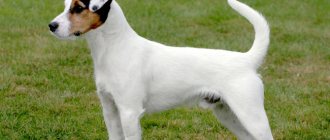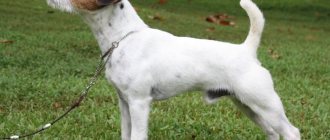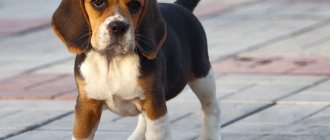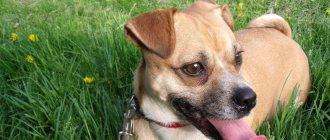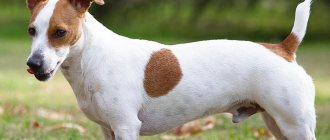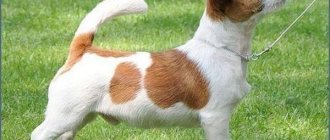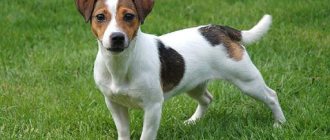The trimming procedure during the shedding of the Jack Russell Terrier will help you get rid of dead hair in a timely manner. Otherwise, the lost hair will cause inconvenience to the pet. Trimming will also help in the fight against dog allergies. In this article we will talk about how trimming should be done and what type of Jack Russell Terrier coat requires this procedure.
Trimming Basics
Trimming is a procedure for removing dead animal hair by plucking, that is, forced shedding. Thanks to trimming, the dog's shedding process accelerates, thereby bringing relief to the pet and less hassle to the owner.
This procedure is entirely manual - the dog's fur is plucked with your fingers. To soften the process, you can purchase special rubber caps that are placed on your fingers.
Trimming not only helps the dog get rid of old hair, especially when he cannot do this on his own, but also allows new hair to grow. Thanks to this procedure, blood circulation in the animal’s skin is stimulated, which has a beneficial effect on the general condition of its coat.
If dead hair is not removed in a timely manner, this will lead to the appearance of tangles, and the pet’s coat will quickly become dirty.
Trimming also has another huge advantage - it eliminates the sources of allergies. After all, an allergy to a dog does not arise from its fur, but from the dead scales of the animal’s skin, which contain the allergen. Regular trimming helps remove allergy irritants.
Trimming is not a quick procedure, because plucking dead hair is not so easy. Newbies often earn themselves bloody blisters. Therefore, in order to cope with trimming, you need to gain some experience and skill.
In order for trimming to take place without pain for the dog, the specialist must be able to determine by touch whether the coat is ready for this procedure. Of course, there are several places on an animal where hair plucking causes him discomfort: on the back of the thighs, under the armpits, around the anus, in the neck and head area.
There is also a stripping technique - a type of trimming that is performed using various available tools: a special knife, a furminator, stones, a comb, pumice, and a nail file.
Health and illness
The Jack Russell Terrier has good health, but there are several diseases to which the pet is prone: the baby’s kneecaps are prone to dislocations, cataracts of the eyes, skin diseases occur due to too dry skin, pure white terriers are prone to deafness.
It looks small, but the Jack Russell can eat enormous portions of food. This can cause your dog to gain excess weight. To protect your terrier, monitor the amount of food eaten and choose the optimal balanced diet. If your dog eats dry food, then it will be easier for you to determine the correct portion. On the packaging of high-quality industrial food, the correct consumption standards are written for different breeds of dogs and their weight.
Find out: What nickname to give a Jack Russell Terrier
Dog coat type
Caring for the Jack Russell Terrier's coat depends on its length.
The Jack Russell Terrier has three coat types:
- smooth;
- hard;
- brocken (intermediate type).
Smooth-haired type
The coat of smooth-haired Jack Russell Terriers fits tightly to the dog's body. Caring for such a pet is very simple. If a dog with a smooth coat type lives in a private house, then it sheds twice a year. If the Jack Russell Terrier lives in an apartment, then the process will last all year.
For such dogs, during seasonal shedding, it is best to carry out the stripping procedure, since the dog’s hair is too short and it will not be possible to pluck it by hand. To complete the process, you can use a furminator.
The Furminator is a comb that looks like a small rake. It does an excellent job of removing dead hair.
Furminators come in different sizes. For Jack Russell Terrier dogs, it is best to purchase a Furminator brand S – small, that is, for small dogs.
You can also give preference to a furminator of the short hair brand - for animals with a short type of coat. But it is better to avoid the Long Hair brand Furminator - it is for long-haired dogs.
The stripping process must be carried out regularly - every two to three months. If you live in an apartment, then you should do this much more often - once or twice a month.
Wirehaired and Brocken type
Jack Russell Terriers with rough and broken coats shed unnoticed, as the dead hair remains on the dog's body. As a result, the animal’s fur acquires a yellowish tint, losing its shine. The wool begins to disintegrate into separate strands, as the coat ceases to be elastic, as a result of which the Jack Russell Terrier becomes unkempt and shaggy in appearance.
The Jack Russell Terrier's coat grows for about three to four months, twice a year: in spring and autumn. When the hairs reach a certain length, they die off. To help your dog remove old fur, a furminator alone is not enough - regular trimming is necessary. Thanks to this procedure, your pet will grow a new coat faster.
It is necessary to start plucking dead hair from an early age of the dog - at four months, so that the Jack Russell Terrier can get used to the procedure. By four months, your pet's puppy hair will die off, so removing it will be easy and painless. Next, you need to repeat trimming every two to three months.
Jack Russell Coat Types
According to coat type, Jack Russell terriers are divided into:
- Smooth-haired;
- Brocken;
- Wirehaired;
Smooth Terriers
Smooth-haired Jack Russells have short hair that lies close to the body. However, they have a peculiarity - such a terrier sheds all year round. Therefore, it must be combed regularly with a furminator (1-2 times a week). Also, such a dog needs to be brushed every day with a rubber brush. Smooth-haired Jack Russells do not need trimming.
Brockens
Brocken is a transitional coat type between smooth and hard. Brocken is no longer Gladysh, but also not Gesture. The Brocken's coat is longer and coarser than that of smooth-haired terriers, and, unlike the coat of wire-haired terriers, it lies tightly to the body. Brockens, just like Wirehaired Terriers, require trimming.
Wirehaired Terriers
Geese have even longer, stiffer and denser fur than Brockens. Gestures do not leave anyone indifferent with their beards and eyebrows, which make them look like funny little old men. However, if the coat of the Wirehaired Jack Russell Terrier is not taken care of (trimmed), the dog will look shaggy and unkempt.
First time
The trimming procedure is a difficult job, so it is best to go to a special salon where a professional will help you and your Jack Russell Terrier.
Choose a professional carefully; he must not only do his job perfectly, but also treat your pet with the utmost delicacy and patience.
Some disloyal masters do not look at the condition of the animal; they ask to put a muzzle on it, forcefully sit it down and hold it during trimming, after which they pluck the whining dog without paying any attention to it.
After such an attitude, the Jack Russell Terrier may begin to have mental problems. At best, he will temporarily refuse such trips until you find an attentive and kind master. At worst, he will always be afraid of such events.
To make the first trimming successful for your dog, you need to follow the following recommendations:
Firstly, you should not bathe your pet before the procedure. It is much easier for a master to work with dirty wool - it is easier to hold it, while clean wool often slips out of his fingers.
Secondly, if after trimming you notice that your Jack Russell Terrier is shaking its head or trying to comb some plucked area, don’t worry. Carefully examine the dog - if there is no irritation, the ears are clean, then this is simply the pet’s reaction to the procedure. Everything should go away in a couple of weeks.
Third, when you get home, be sure to give your Jack Russell Terrier a shower. The water should be warm and the stream strong enough. This way you will wash away the remaining dead particles of skin and fur from your pet, and also prevent possible irritation on its delicate skin.
Fourthly, if you trimmed your dog in the winter, be sure to dress him in a blanket or overalls before going outside. Otherwise, the Jack Russell Terrier may catch a cold.
Jack Russell Terrier. You often ask these questions
Contents hide
The Jack Russell Terrier is a dog breed that is rapidly gaining momentum. These small, funny and smart dogs are loved by residents of large cities in our country. You can even talk about a surge in the popularity of the breed: go out into any yard and be sure to meet at least a couple of restless pets! Together with our British colleagues, we have prepared a selection of questions most frequently asked by both current and potential Jack Russell owners!
Does this breed have any health problems? Let us please the owners and admirers of these wonderful dogs: the breed is considered generally healthy. Most likely, you will not encounter serious hereditary diseases if you purchase a puppy from a responsible breeder or from a specialized nursery. At the same time, we emphasize that certain diseases still occur: Perthes disease, cerebellar ataxia, patella dislocations, spinocerebellar ataxia, lens luxation, etc.
What is the average lifespan of the breed? As noted above, the Jack Russell is a medium-sized breed; this means that the average life expectancy is slightly higher than that of large breed dogs. With good care and regular preventative examinations from a veterinarian, your pet will live approximately 13-17 years. Give your dog regular exercise and maintain an active lifestyle. Monitor your pet's weight: excess weight reduces life expectancy by an order of magnitude!
Why do many Jack Russells tremble? This is a feature of the breed: dogs tremble and even shake when they are very excited about something, as well as at the moment of detecting prey. In some cases, dogs are shaken by trembling in moments of severe fright; Many dogs have the habit of hiding either behind the owner or at his feet. According to owners' reviews, Jack Russells are terrified of thunderstorms - in severe bad weather they are also overcome by “shaking.” Why is this happening? One of the main character traits of the Jack Russell is vigilance. Your dog is always on the alert. Vigilance is literally written into his subcortex! This is why there is such a quick and “nervous” reaction to seemingly ordinary events.
How aggressive are Jack Russells? There is no cause for concern if your pet was socialized at an early age, he was “introduced” to people, pets, your friends’ pets, etc. Sometimes the breed exhibits properties that are, to some extent, inherent in all dogs of the terrier group: adult males show hostility and aggression towards each other.
How easy is it to train and train dogs? Jack Russells are very smart and understanding. In experienced hands, the breed quickly “opens up”, demonstrating its best qualities. The key to success: early start of training, coupled with systematicity and consistency. Ideally, start training your puppy at the age of 8 weeks - that is, from the age when the baby can live an independent life. First, “play” more than “learn.” The more game moments you enter, the better. Do not give small puppies strong physical activity, take care of their joints.
How smart are Jack Russells? Very smart! We noted above that the breed is easy to train. And both good and bad! We emphasize: be consistent. Be a strict but fair boss, don’t give in any slack. Make it clear right away who is “in charge” in your couple. Miss this moment and you will immediately have problems.
How much does this breed shed? Quite abundantly, the peak of molting occurs in spring and autumn. Get a powerful vacuum cleaner right away! Brush your pet regularly. If necessary, show it to specialists.
Is it true that Jack Russells can jump high? Pure truth! No wonder they say that these dogs have “a spring in their legs.” Your little dog is able to immediately jump up to a height of one and a half meters, and this is not the limit. So be careful when letting your pet run around in the garden!
How does a Jack Russell tolerate cold? Some dogs have proven themselves to be gentle and heat-loving creatures (but, admittedly, not all). Is your pet one of them? See how he behaves when cold weather sets in. If you greet the first frost with chills, then buy several warm suits, you really need them. In extreme cold, many owners additionally wrap their pets in their own jackets!
How much does it cost, where to buy? The breed is practiced by both nurseries and private breeders. Given the growing popularity of the breed, there are many offers on the market. In the capital region, they will ask about 20-50 thousand rubles for a purebred puppy.
Want to know more about the breed?
Take a look at our electronic encyclopedia! Photo: pixabay.com
Trimming or cutting
Many Jack Russell Terrier owners think that trimming is only necessary for dogs preparing for shows. And if the pet was purchased as a pet, then all it needs is a haircut.
But these are completely wrong judgments. If the dog is cut instead of trimming, its coat will deteriorate. Processing with scissors will make the hairs soft and fluffy. As a result, the wool will lose its stiffness.
Each coat of a Jack Russell Terrier has a thin base and a thick, hard tip. If you pluck it, a hair of the same shape will begin to grow in its place. If you cut it, it will start to grow from the weak part.
After cutting, it is almost impossible to restore the previous structure of the coat. This will require a lot of time, labor-intensive work and professionalism. But even after this, the wool will not return to its ideal natural state.
How to care for a Jack Russell Terrier
The dog owner should take care of the ears, eyes, teeth and claws. Bath your pet and brush it on time. The Russell's coat is short and usually does not need trimming. You can comb it once every few days, but when the dog sheds, you need to comb out the old fur more often.
- bathed once every two weeks. When washing, keep an eye on your ears so that no water gets in there; you can use tampons for this. Wipe your paws after every walk outside.
- Don't forget to take care of your teeth ; terriers and other dogs develop plaque from eating natural food. You need to brush your teeth with a special dog toothpaste. If you notice inflammation on your gums, take them to the vet.
- Don't forget to check your ears; dogs often have inflammation and infections. Use lotion to care for your ears. It makes it easier to clear the ear of wax contamination.
- walk your dog in places that are well visible and where there is enough space for your terrier to run around. Take a ball for a walk; the more tired the dog gets during the walk, the calmer it will be at home. Remember: if a dog doesn't expend enough energy, he will be irritable. Proper care of a Jack Russell Terrier can add several years to its life. Such dogs can live up to 16 years.
Conclusion
If there is no particular hassle with smooth-haired Jack Russell Terriers, then you need to think seriously before purchasing a pet with a hard or brocken coat type. After all, such a coat will require regular and careful care.
If you have enough time and money for the trimming procedure, then this is your option.
Do you take your dog for trimming? How is she coping with the procedure? Share with us in the comments.
Character of Jack Russell Terrier
All dog breeders unanimously say that Jack Russell is a courageous, persistent, loyal and obedient dog to its owner. She will feel great in the company of strangers or children. The terrier does not like cats, this is most likely due to the hunting instinct. But when a dog grows up with a cat from puppyhood, it does not show hostility, but rather spends fun time playing together.
Brave Jack, ready to protect his master at any moment. In North Africa, such dogs are taken with them to hunt cobras. Yes, exactly those poisonous snakes! Unfortunately or fortunately, the Jack Russell Terrier does not feel the fear of death and for him all this is like another dog running after a cat.
In addition to all the hunting and sporting talents, pets participate in various programs to help sick people. They help children with autism, the chronically ill, and also work with the elderly. Russell terriers can be found at customs when checking drugs prohibited for transportation. The potential in such dogs is very great and people are still trying to teach them new things useful for humans.
Jack Russell Terrier coat care
Caring for the coat of a Jack Russell Terrier is not particularly difficult.
It is most simple if the dog is smooth-haired. The dense, thick coat of these dogs is designed to help them while working in the hole, so it adheres to the skin, creating an impenetrable shirt, the thickness of which depends on the time of year (the amount of undercoat). Dogs with such hair shed seasonally if they live in the yard and constantly shed if they spend their time in warm city apartments. They are wiped once a week with a damp terry towel or combed with special rubber brushes that remove dead wax from the surface of the skin. During shedding, it is convenient to remove old fur using a furminator - this period requires daily attention to your dog's coat. Long-haired Jacks are distinguished by the presence of a beard and mustache, as well as a shaggy, hard coat, which experts divide into two types.
- Brocken. From the English word “broken” - broken, broken. They have wool with a single break, which adheres quite tightly to the body and rarely forms feathers on the paws. Such dogs look shaggy only in the last months before the next trimming, as the overgrown coat loses its elasticity and bristles in different directions.
- Ruf (raf). From the English word “rough” - hard, rough. Each hair of these dogs has two or more kinks and therefore does not adhere to the body, creating the feeling of a shaggy mongrel already in the third month after complete trimming.
The frequency of trimming your Jack Russell Terrier depends on its coat type. Brokens only need one trim every 6 months and a little plucking of the hair on the neck, head and hips, but to maintain the breed's appearance, roofs usually undergo so-called permanent plucking or rolling - they are plucked every three months, but not completely, leaving half the hair on the body .
Brockens and rufas are distinguished not only by their appearance, but also by the degree of development of their beard and mustache - rufas are more bearded. You can accurately determine the type of wool by looking at mature hairs and identifying kinks in them.
Trimming begins from the back of the head and neck, especially in males. At this point, the fur usually comes off completely and there is no point in postponing the problem area for later. Then the belt is pinched along the spine. Next, laying the dog on its side, pinch off the sides, shoulders and hips, first on one side of the dog, then on the other. You can use a trimming knife in these areas. The forehead, head, neck and border area on the neck are treated with fingers, which must be protected with special finger pads. For pet-class dogs, it is recommended to pinch off the entire muzzle, but it is better to discuss this issue with the owner in advance. Show dogs are given a small beard and mustache.
The anal area and groin can be cut with a clipper. The inside of the ears is pinched off, and the hair is plucked from the ear canal using a special powder.
The first trimming is usually carried out at the age of 4 months for Roofs and at 6-7 months for Brokens. Before this, the dog’s body is combed with a fine comb; in addition, it is allowed to pinch off inaccurately sticking out hairs.
During trimming, it is important to ensure that the undercoat left on the dog is smooth and without bald spots, which are formed when a novice groomer is overzealous.
Despite the fact that most often breeders recommend contacting specialists regarding trimming, those owners who want to learn how to take care of their pet’s coat on their own can learn trimming in 2-3 procedures if they take their time and learn to see the dog for what it is. should be after this procedure.
